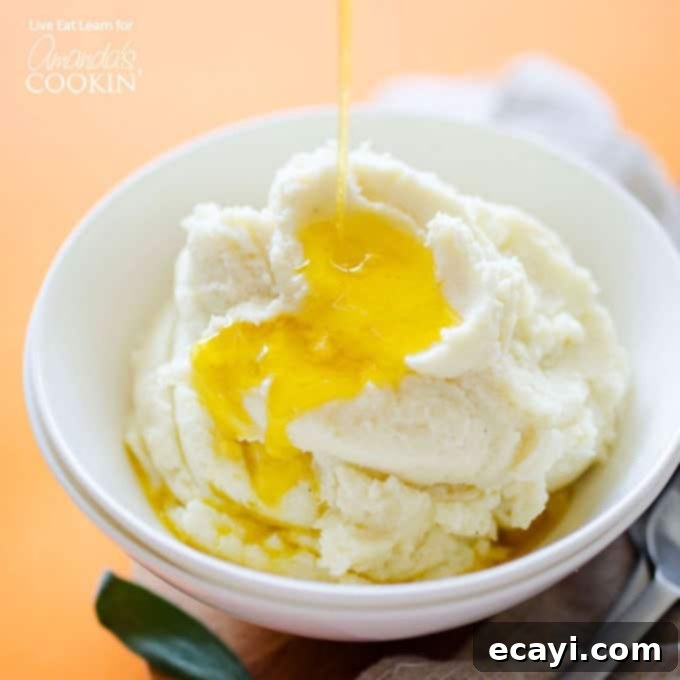Perfectly Creamy Low-Carb Mashed Cauliflower: Your Ultimate Alternative to Mashed Potatoes
Are you searching for a delicious, healthier alternative to traditional mashed potatoes without sacrificing flavor or texture? Look no further! This recipe for creamy mashed cauliflower is a game-changer, offering a low-carb option that’s incredibly fluffy and light, remarkably similar to its potato counterpart. Whether you’re aiming for a healthier lifestyle, following a ketogenic diet, or simply looking to add more vegetables to your plate, this dish is designed to impress. Infused with the rich flavors of cream cheese, aromatic brown butter, and fresh sage, it’s not just a substitute; it’s a stellar side dish worthy of any holiday feast or weeknight dinner.
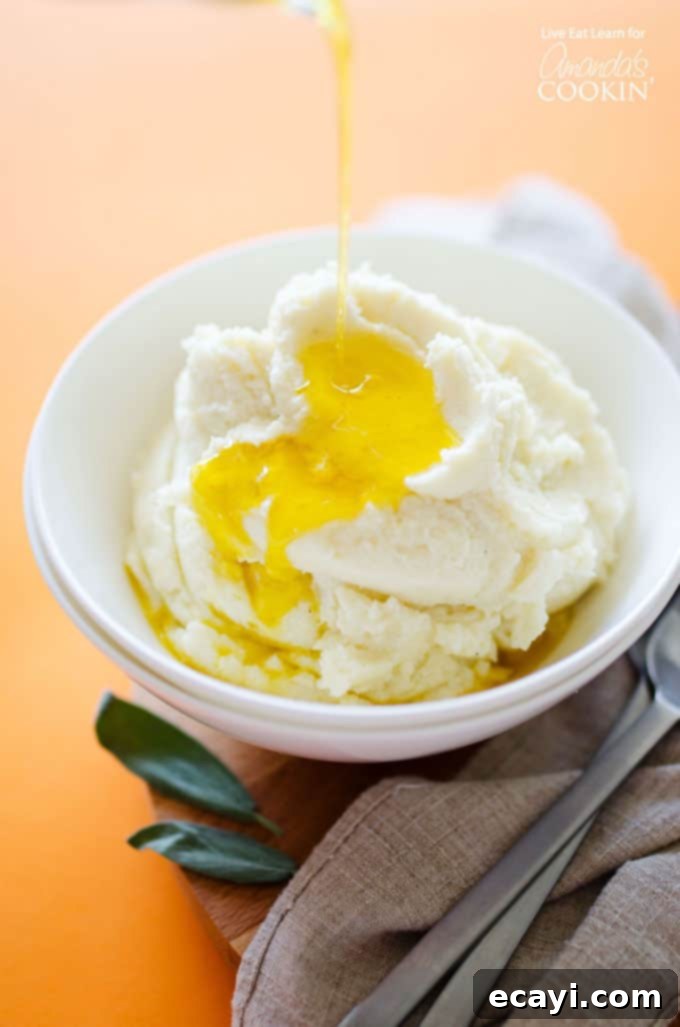
Unlocking the Secret to Amazing Mashed Cauliflower
For many years, the idea of mashed cauliflower simply didn’t appeal to me. My attempts often resulted in a bland, watery, and frankly, soggy imitation of mashed potatoes. I’d boil it, puree it, taste it, and be met with a distinct cauliflower flavor that just wasn’t right. It reached a point where I started to believe anyone praising “faux-potato perfection” was simply exaggerating. But then, I stumbled upon a crucial technique that completely transformed my approach to making mashed cauliflower, and it truly flipped my world upside down. Today, I’m thrilled to share that indispensable secret with you, hoping to eliminate all less-than-amazing mashed cauliflower experiences for good!
The key to achieving that desirable fluffy, light, and creamy consistency lies in one simple, yet often overlooked, step: **eliminating excess moisture.** Cauliflower naturally holds a lot of water, especially after boiling. If you skip this critical step, you’re destined for a watery mash that tastes more like steamed cauliflower puree than a rich side dish. Think of it as the foundation for success – a dry cauliflower base is essential for a velvety smooth final product that truly mimics the texture of mashed potatoes.
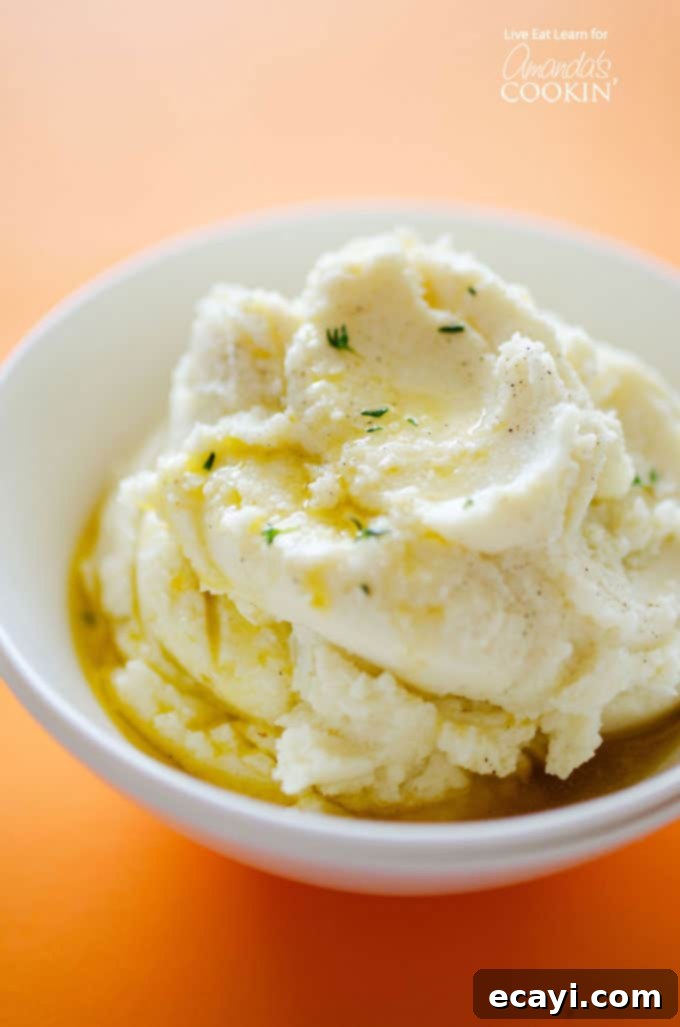
Cauliflower vs. Potatoes: A Nutritional Perspective
Both cauliflower and potatoes are valuable vegetables, offering a range of essential vitamins and minerals crucial for a healthy daily diet. However, for those monitoring their carbohydrate intake, whether for weight management, diabetic control, or specific dietary plans like keto or low-carb, cauliflower presents a significant advantage. Cauliflower contains substantially fewer carbohydrates and calories compared to potatoes. While potatoes are renowned for their potassium content, cauliflower is a good source of Vitamin C, K, and folate, and is also rich in fiber. It’s slightly higher in sodium and a bit lower in potassium than potatoes, but the overall carb reduction is its most compelling feature for many. If detailed nutritional information is a priority for your specific dietary needs, you can easily find comprehensive comparisons, such as the nutritional labels available here.
Choosing cauliflower as your mash base doesn’t just reduce carbs; it also introduces a milder flavor profile that beautifully absorbs the other ingredients, allowing the rich creaminess of the cheese and the nutty depth of brown butter to shine through. This makes it an incredibly versatile canvas for various flavor combinations, ensuring your low-carb alternative is anything but boring.
This post contains affiliate links. This means if you purchase something through one of these links, I will earn a small commission, at no additional cost to you. Your support helps keep this blog running!
Ingredients You’ll Need for the Perfect Mashed Cauliflower:
- 1 large head of cauliflower (choose a firm, white head with no blemishes)
- 4 Tbsp cream cheese (softened to ensure smooth blending)
- Pinch of salt and pepper (to taste, adjust as needed)
- 4 Tbsp unsalted butter (for browning, adds incredible depth)
- 1 tsp chopped fresh sage (a fantastic aromatic herb for holiday flavors)
Essential Kitchen Tools for this Recipe:
- Chef’s knife (for easily breaking down the cauliflower)
- Large pot or a Dutch oven (for boiling the cauliflower to tenderness)
- Cheesecloth (the secret weapon for moisture removal, or a sturdy clean kitchen towel)
- Food processor (for achieving that perfectly smooth and creamy puree; check out these food processor recipes for more ideas!)
- Skillet (preferably a light-colored one to easily monitor the browning butter)
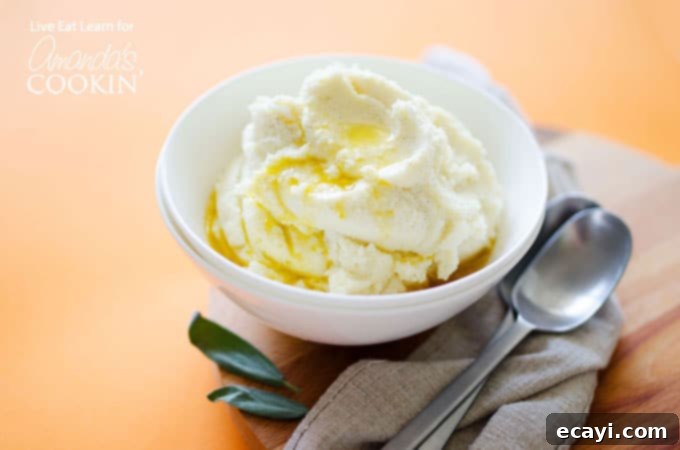
The Game-Changing Secret: Moisture Removal
So, here it is, the secret that will elevate your mashed cauliflower from merely “okay” to absolutely incredible: **get all the moisture out!** We begin by boiling the cauliflower until it’s perfectly tender, a crucial step for a smooth mash. However, once cooked, it’s equally crucial to extract all that absorbed water. Failing to do so will result in a soupy, bland, and mushy cauliflower mash that simply won’t have the desired texture of potatoes.
You can achieve this in a couple of effective ways. One method is to press the cooked cauliflower through a fine-mesh sieve using the back of a spoon, forcing the water out. A more efficient and highly recommended method is to place the cauliflower in a clean dishcloth or, even better, a cheesecloth. Gather the edges of the cloth and twist tightly, squeezing out as much liquid as humanly possible. Don’t be shy with your strength here; the more moisture you remove, the fluffier and creamier your mashed cauliflower will be. You’ll be surprised at how much water comes out! This meticulous drying process is what truly transforms the cauliflower, allowing it to take on that familiar potato-like consistency without any trace of sogginess.
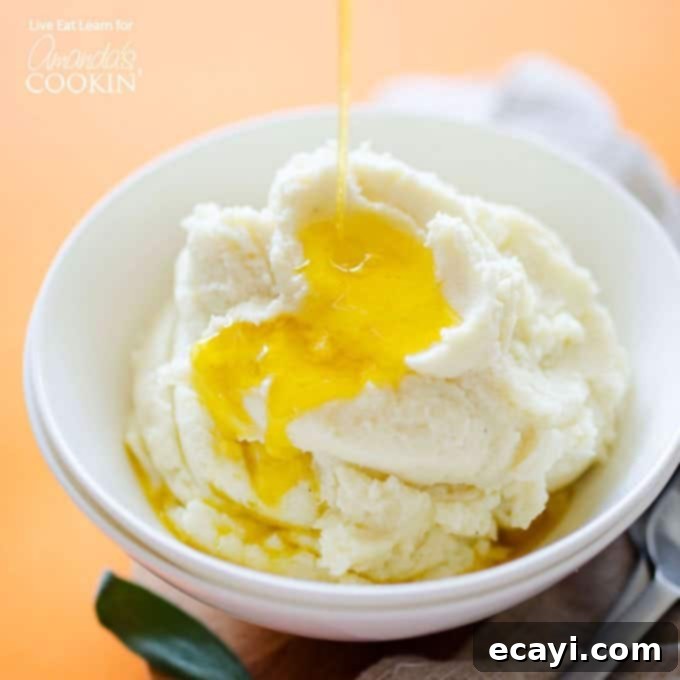
Once the cauliflower is thoroughly drained, it’s ready for its transformation. Speaking of pureeing, **cream cheese** acts as the crowning glory to this fluffy mashed cauliflower secret. We add a generous touch of softened cream cheese not only to bind the mash but also to significantly enhance its creamy texture and rich, smooth mouthfeel. It provides a subtle tang that complements the cauliflower beautifully, making it irresistibly indulgent. For an extra layer of gourmet flavor, we’ll top this exquisite mash with **browned butter and fresh sage**. The browned butter develops a nutty aroma and deepens the overall flavor, while the sage adds a fragrant, earthy note that is simply perfect, especially for holiday gatherings. Serve immediately and watch it disappear!
Chef’s Note: The prep time for mashed cauliflower is remarkably shorter than for mashed potatoes. There’s absolutely no peeling required for cauliflower, which saves a significant amount of time, especially when you’re preparing a large holiday dinner or a quick weeknight meal. This efficiency makes it an even more appealing choice for busy cooks!
SCROLL DOWN FOR THE PRINTABLE VERSION OF THIS RECIPE CARD

More Delicious Side Dishes You Might Enjoy:
- Potatoes Au Gratin have long been a beloved classic in many households. Elevate this comfort food by adding crispy bacon and tender leeks for an unbelievably flavorful side dish that everyone will adore!
- If you’re still craving potatoes, these potatoes, perfectly roasted in a cast iron skillet, are bathed in a savory broth, making them incredibly tender and utterly irresistible.
- While often associated with Thanksgiving, stuffing (or dressing, as some call it) is a delightful accompaniment to poultry at any time of year. Try my aromatic stuffing with parsley, sage, rosemary & thyme (does anyone else hear the song?) for your next chicken or turkey meal.
- For a vibrant and flavorful addition with a Southwestern flair, this Spanish rice with black beans and corn is a fantastic and satisfying side dish that adds color and zest to any plate.
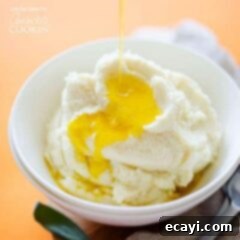
Creamy Mashed Cauliflower with Brown Butter & Sage
IMPORTANT – There are often Frequently Asked Questions within the blog post that you may find helpful. Simply scroll back up to read them!
Print It
Pin It
Rate It
Save ItSaved!
Ingredients
- 1 large head of cauliflower
- 4 Tbsp cream cheese, softened
- Pinch of salt and fresh ground black pepper
- 4 Tbsp unsalted butter
- 1 tsp freshly chopped sage leaves
Instructions
-
Begin by bringing a large pot of water to a rolling boil. Carefully chop the cauliflower into uniform, golfball-sized chunks, ensuring you remove the tough inner stem and any green leaves. Add a generous pinch of salt to the boiling water, then add the cauliflower florets. Cook for 6 to 10 minutes, or until the cauliflower is completely fork-tender.
-
This is the crucial step! Working in batches to avoid overcrowding, transfer the cooked cauliflower into a clean dishcloth or a sturdy cheesecloth. Gather the edges of the cloth and twist tightly, exerting as much pressure as possible to wring out every last drop of moisture. This step is vital for preventing a watery or soggy mash.
-
Once thoroughly drained, place the cauliflower and softened cream cheese into a food processor. Process until the mixture is completely smooth and creamy, scraping down the sides as needed to ensure no lumps remain. Cover the bowl to keep the mashed cauliflower warm while you prepare the brown butter.
-
In a light-colored skillet (which helps you monitor the color change), add the butter and place it over low to medium heat. Allow the butter to melt completely. Once melted, add the freshly chopped sage leaves. Continue cooking, stirring occasionally. The butter will first bubble vigorously, then after about 5 minutes, it will begin to develop a delightful nutty aroma and darken in color. When small dark brown bits start to form at the bottom of the pan and the butter has reached a light caramel color, immediately remove it from the heat to prevent burning. Pour the warm brown butter and sage mixture directly over the mashed cauliflower. Stir gently to combine, then serve immediately for the best flavor and texture.
The recipes on this blog are tested with a conventional gas oven and gas stovetop. It’s important to note that some ovens, especially as they age, can cook and bake inconsistently. Using an inexpensive oven thermometer can assure you that your oven is truly heating to the proper temperature. If you use a toaster oven or countertop oven, please keep in mind that they may not distribute heat the same as a conventional full sized oven and you may need to adjust your cooking/baking times. In the case of recipes made with a pressure cooker, air fryer, slow cooker, or other appliance, a link to the appliances we use is listed within each respective recipe. For baking recipes where measurements are given by weight, please note that results may not be the same if cups are used instead, and we can’t guarantee success with that method.
